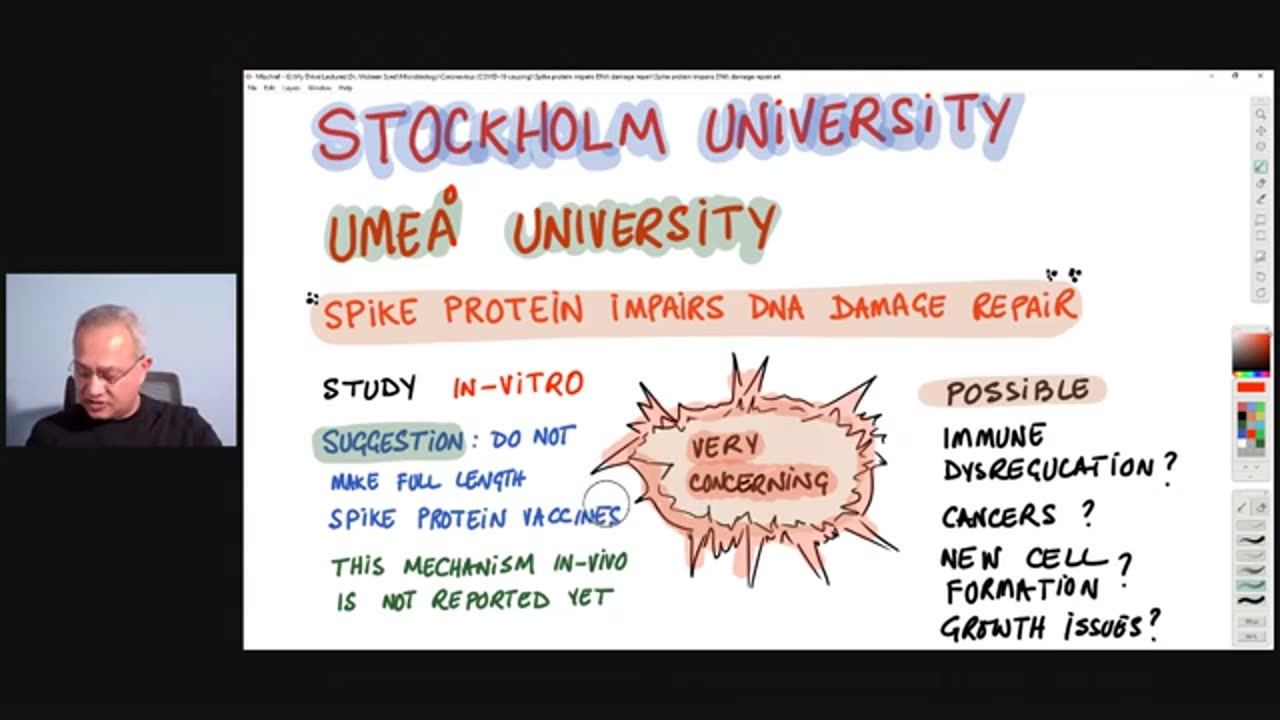Premium Only Content

Spike Protein Goes to Nucleus and Impairs DNA Repair (In-Vitro Study)
https://www.youtube.com/watch?v=-SYL-iU0E9Q&t=1349s
Spike Protein and DNA Repair Impairment
The study found that the SARS-CoV-2 spike protein could bind to and inhibit the activity of two DNA repair proteins: DNA polymerase β and APE1. DNA polymerase β is responsible for repairing single-strand breaks in DNA, while APE1 is responsible for repairing double-strand breaks in DNA.
The researchers also found that the SARS-CoV-2 spike protein could inhibit the activity of a protein called V(D)J recombinase. V(D)J recombinase is a protein that is essential for the process of V(D)J recombination, which is how B cells and T cells generate their diverse repertoire of receptors.
🧬 The spike protein of the virus can enter the nucleus and impair DNA repair, potentially leading to significant side effects.
🧬 Spike protein impairs DNA repair, potentially leading to genetic damage and instability.
🌡️ According to researchers, preventing this impairment may involve using smaller subunits of the spike protein in vaccines, such as the RBD or other parts of the virus.
🧪 The presence of certain repair enzymes, such as BRCA1 and 53BP1, is crucial for fixing DNA breaks caused by the virus.
🦠 "When SARS-CoV-2 infects a cell, it impairs DNA repair and can potentially cause more harm."
Complexity of Viral Replication and DNA Repair
🦠 The process of virus replication involves the production of various proteins, which are then assembled and packaged before the virus is released from the cell, highlighting the complexity of viral replication within the host.
🧬 "If there are DNA breaks during the cell cycle, there are strict mechanisms to ensure correct repair and prevent the formation of cancer cells."
🧪 Different phases of the cell cycle require different DNA repair mechanisms, highlighting the complexity of the repair process.
🌡️ Proliferation of cells, caused by infection, can result in an increased number of cells and potential DNA damage, highlighting the importance of the immune system response.
🧪 In-vitro studies suggest that the messenger RNA for producing DNA repair enzymes is transcribed in the nucleus and then sent outside for translation, highlighting the complex communication between the nucleus and cytoplasm in cellular processes.
-
 LIVE
LIVE
Man in America
8 hours ago🚨 BREAKING: Dr. Robert Young JAILED! Medical Tyrants Will Do ANYTHING to Silence Truth
1,239 watching -
 LIVE
LIVE
I_Came_With_Fire_Podcast
6 hours agoPanama CANAL BlackROCKED | Left of PODCASTING | Ukraine AID GONE
312 watching -
 45:56
45:56
Glenn Greenwald
5 hours agoLee Fang Reacts to Trump's Speech to Congress; Will DOGE Tackle Military Waste? | SYSTEM UPDATE #418
58.8K61 -
 43:23
43:23
Donald Trump Jr.
5 hours agoNo Clap: Dems are a Disgrace but My Father is Bringing Back Common Sense | Triggered Ep.222
102K91 -
 18:29
18:29
The Rad Factory
1 day ago $0.02 earnedBuilding Shred Eighty a Custom Honda Snow Kart
1.51K2 -
 UPCOMING
UPCOMING
Precision Rifle Network
1 day agoS4E7 Guns & Grub - What makes group size increase?
1.12K1 -
 46:29
46:29
SGT Report
23 hours agoAMERICA IS BACK! BYE BYE IRS!! -- Sam Anthony
40.9K76 -
 8:56:13
8:56:13
Dr Disrespect
12 hours ago🔴LIVE - DR DISRESPECT - WARZONE - 150 PLAYER LOBBIES
165K20 -
 1:27:35
1:27:35
Redacted News
6 hours ago"This is NOT normal" Trump just destroyed the woke mob as Dems in disarray | Redacted News Live
147K268 -
 1:39:52
1:39:52
Vigilant News Network
7 hours agoUNHINGED: Dems Say That Elon Needs to ‘Go Back to AFRICA?’ | The Daily Dose
95.4K19